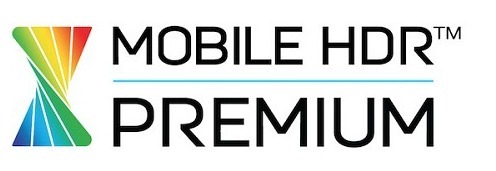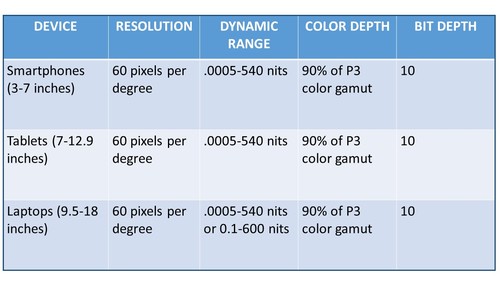|
|
|
Contributors | Messages | Polls | Resources |
|
UHDA's Schinasi Talks Mobile Video Quality The Ultra-High Definition Alliance (UHDA) was formed to drive consumer adoption of UHD TVs. Its goal is to help consumers navigate additional enhancements to the television experience beyond just increased resolution. While UHD TV shipments are ramping up faster than HDTV did, there is still considerable market confusion as consumer struggle with terms such as high dynamic range (HDR), wide color gamut (WCG), bit depth and higher frame rate (HFR). These are all part of the UHD standard, beyond just the 4K resolution. Telco Transformation discussed the purpose and goals of the UHD Alliance with Dan Schinasi, chairman of the US Promotions Working Group at IBC last year. (See UHDA's Schinasi on Defining Premium UHD.)
Since then, the UHDA has developed a new set of criteria aimed at mobile devices, to help simplify the video performance of "portable battery-operated display devices" -- basically smartphones, tablets and laptops. These new requirements for "Mobile HDR Premium" certification were announced at Mobile World Congress earlier this month. We caught up with Schinasi for a quick overview of the new certification. Telco Transformation: What led to the development of the new certification from the UHDA? Dan Schinasi: Well, the alliance was always about certifying the premium viewing experience so that consumers can more easily identify the devices that offer it. We started out with UHD TV sets and Blu-ray players, and this is just an expansion of the ecosystem. It extends that "premium" certification to portable battery-operated devices, basically smartphones, laptops and tablets. Now manufacturers [that satisfy the UHDA's criteria] can get that premium certification that exists for UHD TVs. Mobile is an important category, spending on mobile is now outpacing other device categories. I think I saw a statistic somewhere that said it would take a person 1 million years to watch all the video traffic being distributed on mobile. TT: What does a device need to do to satisfy the requirements for a "Mobile HDR Premium" certification? DS: The approach was similar to that for the specs for TV display products. The device needs to support HDR, color space, color bit depth and resolution.
TT: The UHDA has classified resolution differently for the mobile devices than the typical lines of resolution for TV sets that we are used to. How does 60 pixels per degree map on to more familiar metrics like HD and 4K? DS: Since these devices are often viewed from very close distance, this is a better way to think about it [visual quality.] It uses a scientific approach to identify the best possible quality that the eye can discern at that distance. You can of course have devices with higher resolution, but this would be the maximum resolution that the eye can discern. At the estimated distances, 60 pixels per degree maps onto full HD (1920 x 1080) for devices in the 3-7 inch range, like most smartphones. For larger displays, in the 7-12.9 inch range, typically tablets, it would be QHD -- 2560 x 1440. And for laptops up to 15.6 inches, it's the same (2560 x 1440) but for 17-inch laptops and above, we would go up to QHD+, at 3200 x 1800 resolution. We're not disparaging 4K at all here, in fact we want to encourage it. But understanding that the viewing distance isn't great, it wouldn't make a huge difference. Apple has a similar term, I think they try to make the same distinction… they call it "retinal level resolution," or something like that. But it's the same principle, that it's the highest quality that the eye can discern.
TT: Have any devices been certified yet? DS: Some are in the certification process now. We have had no announcements yet, but I can tell you several members have products in the pipeline. Also, the way it works with the UHDA is that the alliance announces the standard first, and then members can follow. The members were keen to announce [the development of the certification] at Mobile World Congress, but they will announce their own products shortly. Maybe another take-away should be that specs are always forward looking. Part of their role is to encourage the rollout of new technology. Sometimes specs are for technology available today, and sometimes it's for technology that is developed in the months and years ahead. TT: Are there segments that are more keen to adopt these guidelines, or are pushing harder? DS: There is interest from multiple industries that deal with computing and smartphones -- particularly manufacturers and streaming partners. We need content obviously, to have such services, so the content guys are also interested. News will be forthcoming from the individual companies soon. — Aditya Kishore, Practice Leader, Video Transformation, Telco Transformation |
In part two of this Q&A, the carrier's group head of network virtualization, SDN and NFV calls on vendors to move faster and lead the cloudification charge.
It's time to focus on cloudification instead, Fran Heeran, the group head of Network Virtualization, SDN and NFV at Vodafone, says.
5G must coexist with LTE, 3G and a host of technologies that will ride on top of it, says Arnaud Vamparys, Orange Network Labs' senior vice president for radio networks.
The OpenStack Foundation's Ildiko Vancsa suggests that 5G readiness means never abandoning telco applications and infrastructures once they're 'cloudy enough.'
IDC's John Delaney talks about how telecom CIOs are addressing the relationship between 5G, automation and virtualization, while cautioning that they might be forgetting the basics.
 On-the-Air Thursdays Digital Audio On-the-Air Thursdays Digital AudioARCHIVED | December 7, 2017, 12pm EST
Orange has been one of the leading proponents of SDN and NFV. In this Telco Transformation radio show, Orange's John Isch provides some perspective on his company's NFV/SDN journey.
 Special Huawei Video Special Huawei VideoHuawei Network Transformation Seminar The adoption of virtualization technology and cloud architectures by telecom network operators is now well underway but there is still a long way to go before the transition to an era of Network Functions Cloudification (NFC) is complete. |
|
|
|
||




















